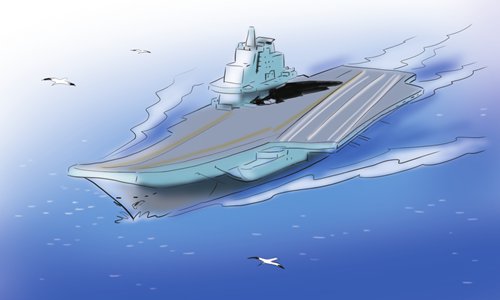
The People's Liberation Army (PLA) Navy marked its 69th anniversary on April 23. On the same day, China's first domestically built aircraft carrier, known as the Type 001A, went through its inclining test. It is set to begin its maiden sea trial, demonstrating the growing capabilities of the PLA Navy which is inching closer to its ambitions of building a modern aircraft carrier.
Since the 21st century, the development of the PLA Navy's warships has taken short quick steps, employing gradual innovation and developing smaller groups of transitional types in a short period of time. Through the rapid accumulation of experience and testing, development can take a great leap forward.
The launch of the Type 055 destroyer demonstrated important leaps in the development of China's warships by taking short quick steps since the development of the Type 052B destroyer at the beginning of the 21st century.
The Type 001A carrier's design is slightly modified and upgraded compared to China's first carrier Liaoning. With the optimization of its deck, hangar and internal structure, the new model basically eliminates the hallmarks of a Soviet-era carrier like the Liaoning. It increases the number of carrier-based planes and improves the take-off and landing efficiency.
By taking short quick steps, the vessel can be built and put into use in a short period of time, which avoids project delays and the technological hazards that come with too radical a leap in technology.
Initial work on the Type 001A aircraft carrier began in 2013. It was launched in 2017 and will begin its maiden sea trial in the first half of 2018. The speed of development is faster than other countries.
Once the aircraft carrier goes into use, the PLA Navy can start all kinds of warship training and formulate formation tactics as soon as possible, which helps them to quickly improve combat effectiveness.
Safety work, take-off and landing training, aircraft carrier and convoy ship formations require coordinated long-term and frequent drilling and cannot be the work of a single day.
Time is the most valuable asset. If the Type 001A can be commissioned into the PLA Navy and become combat ready as early as possible, the battle group of two carriers will multiply the navy's ability to project power and considerably enhance China's maritime deterrence. China can be more flexible with two carriers. In the face of long-term maritime security competition, China will gradually expand its maritime interests to include three or four new carriers, at the least, to meet its strategic needs.
While Liaoning became the first carrier of China, the Type 001A is a transitional type with a huge gap between it and carriers of the US, Britain and France. China must renew efforts and innovate to catch up with these countries.
The Type 001A relies on a ski jump-style launch system, which is its biggest weakness. In this case, the fully-loaded aircraft can only take off at one point and are unable to land simultaneously. This cripples the attack efficiency of carrier-based aircraft and also its combat effectiveness. The ski jump-style launch mechanism also restricts the use of fixed-wing airborne early warning aircraft.
China can launch the J-15T aircraft from a land-based electromagnetic aircraft launch system. With more technological progress, China will likely install an electromagnetic aircraft launch system on future carriers.
The Type 001A should allow for more types of aircraft. The J-15S had its maiden flight on April 24 and is expected to be commissioned together with the newest carrier. Carrier-friendly fixed-wing airborne early warning and refueling aircraft are being developed and will likely appear together with a new catapult on home-built carriers of the future.
With two carriers, the PLA Navy will adjust its structure and doctrine. The Liaoning filled a gap and contributed significantly to personnel training, establishing China's aircraft carrier combat doctrine. The Type 001A serves as a transition from the Liaoning to future carriers with a catapult-based launch system. It follows and uses the experiences gathered on the Liaoning and meanwhile prepares personnel, technology and experience for the next generation of carriers.
The author is an assistant research fellow at the China Institute of International Studies.













